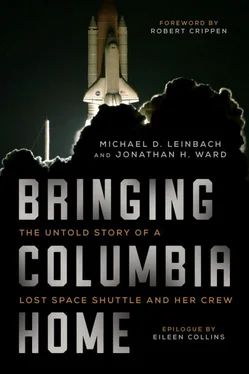Mike Griffin replaced O’Keefe as NASA administrator in April 2005. Griffin believed it was so important to extend Hubble’s life and capabilities that he was willing to reinstate the servicing mission—provided the external tank foam shedding issues were resolved and adequate crew rescue capability existed. KSC and JSC used the Columbia rescue scenario to design a one-time rescue mission that could back up the Hubble servicing mission. Griffin formally approved the servicing mission after the successful completion of STS-121 in July 2006. [8] NASA, “NASA Approves Mission and Names Crew for Return to Hubble,” news release 06-343, October 31, 2006.
On May 11, 2009, Atlantis was poised for launch to the Hubble from Pad 39A at Kennedy. Standing on Pad 39B two miles to the north was Endeavour , ready to go into orbit if any problems occurred with Atlantis . For the first and only time, NASA had two shuttles in launch countdown simultaneously. We were ready to launch Endeavour one day after Atlantis if necessary. Tremendous dedication and work went into getting us to this dual-launch posture. Fortunately—like many other things in the space business—this contingency capability was assured but never needed.
Atlantis ’s flight went flawlessly, so the rescue mission never flew. Atlantis ’s crew successfully prolonged Hubble’s life and upgraded its instrument package.
In a roundabout way, what we learned from the Columbia accident had once again contributed to the advancement of scientific discovery.
—
Columbia ’s STS-107 accident did not end the Space Shuttle Program. However, it informed the decisions that did. As brilliant as the space shuttle’s technology was, the vehicle could never be made acceptably safe to risk further flights after the International Space Station was completed.
Even before the CAIB issued its report, debates about shuttle safety raged within NASA. “That is the pattern in any aftermath of a cathartic event like this,” Sean O’Keefe said. “There will be plenty of things that are emerging now and will continue to emerge that will motivate a change in the way we look at doing business.” [9] “Investigation Could Reshape Space Agency,” Florida Today , March 3, 2003, 3A, quoted in Liston, KSC Chronology of KSC for 2003 , 52.
Fundamental questions resurfaced. Did the benefits of sending humans into space outweigh the risk and expense? Maxime Faget—the legendary engineer who designed America’s Mercury space capsule and managed the design of every other American manned spacecraft—felt that the country should immediately halt all human spaceflights until a safer vehicle could be built. [10] “Designer: Suspend Human Space Program,” Florida Today , May 16, 2003, 11A, quoted in Liston, KSC Chronology of KSC for 2003 , 109–10.
Had it not been for America’s commitments to its international partners to complete the ISS, the Space Shuttle Program could very well have ended with the loss of Columbia . Building the ISS was a matter of international treaty. [11] The International Space Station Intergovernmental Agreement is an international treaty signed on January 29, 1998, by fifteen governments for “a long term international co-operative frame-work on the basis of genuine partnership, for the detailed design, development, operation, and utilisation of a permanently inhabited civil Space Station for peaceful purposes, in accordance with international law.”
We had to see through an endeavor into which the world community had invested tremendous time and resources. Without the shuttle, there was no other way to get the ISS modules into orbit and assemble the station.
Some within NASA naturally felt hesitant to take further risks after the accident. Dave King said, “It shakes your confidence. It shakes every part of you, when you’re part of making decisions that kill your friends and make your friends suffer.” Overcoming the grief and the mood of shared guilt for having let the crew down proved a tough management challenge. Leaders concentrated on rebuilding people’s faith and pride in their work. Ultimately, a driving motivation was the perceived obligation to Columbia ’s crew to carry their mission forward—to ensure that their sacrifice had not been in vain.
In May 2003, NASA named former astronaut Thomas Stafford and retired shuttle astronaut Richard Covey to head an independent task force to evaluate our plans for returning the shuttle to flight. The Stafford-Covey Task Force would provide an ongoing, unbiased assessment of how NASA was implementing the CAIB’s recommendations. As the time for the next mission approached, the task force would advise the NASA administrator whether they felt everything had been done to make the shuttle safe to fly again. [12] “Return ASAP,” Aviation Week & Space Technology , September 29, 2003, 21.
While the space shuttle was being recertified for flight, NASA moved forward with a new “Vision for Space Exploration,” announced by President George W. Bush on January 14, 2004. The Vision called for completing the ISS and retiring the space shuttle by 2010. Meanwhile, NASA would develop the new Constellation Program, which included expendable launch vehicles and the Crew Exploration Vehicle (Orion), which was a capsule like Apollo, but on a larger scale. Crews would begin flying on Constellation in 2014. Constellation would return Americans to the Moon by 2020 and put them on Mars in the not-too-distant future.
Announcing the end of the Space Shuttle Program felt like a crushing blow to many in the NASA community. We had planned to fly the orbiters until at least 2020. Now only a handful more than twenty missions would be left before we retired the shuttle. United Space Alliance’s Larry Ostarly said, “Quite frankly, I don’t know what made me sadder—that we lost Columbia , or that it cost the program.”
—
In late 2003, program managers and leaders at the NASA centers began identifying the changes to hardware, processes, and practices to address the findings in the CAIB report, as well as other findings that came to light during the investigation. Engineers at Marshall Space Flight Center reeducated the workforce in the proper procedures for applying foam to the external tank. Johnson Space Center engineers developed hardware and techniques for inspecting and repairing a shuttle in orbit. The first several days of a mission would now include a complete inspection of the shuttle’s heatshield, both by the crew on the shuttle and by astronauts inside the International Space Station, who would photograph the shuttle as it approached. We overhauled our inspection and processing procedures at Kennedy and significantly improved the tracking camera coverage for future launches. Redesigned flight plans allowed launching only in daylight hours, to allow cameras to monitor the ascent phase of the mission. Critical phases of reentry could fly only over unpopulated areas. Mission Management Teams would be required to meet every day the shuttle was in orbit, no matter how well things seemed to be going. Roy Bridges established NASA’s Engineering and Safety Center at Langley Research Center, providing a resource any engineer could call with a concern that they believed needed to be examined.
Shuttle Program managers implemented sweeping changes to address the organizational culture issues the CAIB identified. Mission managers would be required to attend specialized training sessions about how to foster full and open debate on any issue. Searching out dissenting opinions became the norm and was embraced throughout the program. No longer would lower-level employees feel reluctant to speak up if they had an issue or alternative opinion.
Читать дальше











